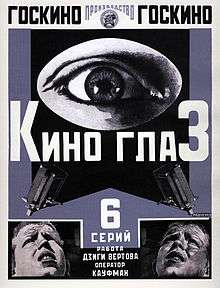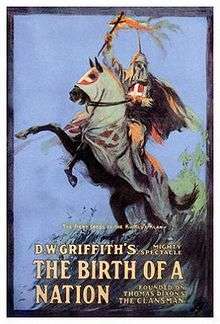Cinema 1: The Movement Image
.jpg) Cover of the French edition | |
| Author | Gilles Deleuze |
|---|---|
| Original title | Cinéma 1. L'Image-Mouvement |
| Translator | Hugh Tomlinson |
| Country | France |
| Language | French |
| Subject | Philosophy, Film theory |
| Published | 1983 (Les Éditions de Minuit) |
| Media type | |
| Pages | 296 |
| ISBN | 2-7073-0659-2 |
| OCLC | 11089931 |
| Preceded by | Francis Bacon - Logique de la sensation (1981) |
| Followed by | L'Image-temps. Cinéma 2 (1985) |
Cinema 1: The Movement Image (French: Cinéma 1. L'Image-Mouvement) is a 1983 book by the philosopher Gilles Deleuze, in which Deleuze combines philosophy with film criticism. In the preface to the French edition Deleuze says that, "This study is not a history of cinema. It is a taxonomy, an attempt at the classifications of images and signs" and acknowledges the influence of the American pragmatist C.S. Peirce and the French philosopher Henri Bergson (p. xiv). The cinema covered in the book ranges from the silent era to the 1970s, and includes the work of D. W. Griffith, Abel Gance, Erich von Stroheim, Charlie Chaplin, Sergei Eisenstein, Luis Buñuel, Howard Hawks, Robert Bresson, Jean-Luc Godard, Sidney Lumet and Robert Altman. The second volume, Cinéma 2, L'Image-temps was published in 1985 (translated as Cinema 2: The Time-Image in 1989). Both books are clearly about cinema, but he also uses cinema to theorise time, movement and life as a whole.[1]
The movement-image
Deleuze, commenting on the philosophy of Henri Bergson, dismisses the conception of cinema as a succession of still photographs. Instead, he argues that cinema immediately gives us movement-image.[2] Figures are not described in motion; rather, the continuity of movement describes the figure (p5). In this respect, cinema embodies a modern conception of movement, "capable of thinking the production of the new" (p7), as opposed to the ancient conception of movement as a succession of separate elements, exemplified by Zeno's arrow. The capacity for thinking the production of the new, being open to chance and accident, can be seen in the action-mime of Chaplin and the action dance of Fred Astaire (p7).
Frame and shot
That which is within the frame (characters, props) is a relatively closed system, and can be treated as a spatial composition. However, it can never be completely closed, because of the way it can define the "out-of-the-frame". This is particularly apparent in the films of Michelangelo Antonioni. Deleuze defines the shot (which is dependent on the position and movement of the camera) as the movement-image (p22). The mobile camera acts as a general equivalent to forms of locomotion, for instance walking, planes, cars (p22). The great moments of cinema are often when the camera, following its own movement, turns its back on a character (p23). In this way, the camera acts as a mechanical consciousness in its own right, separate from the consciousness of the audience or the hero (p22). Montage (the way the shots are edited) connects shots and gives movement, even when the camera is not mobile.
Montage
Different conceptions of duration and movement can be seen in the four distinct schools of montage: the organic montage of the American school, the dialectic montage of the Soviet school, the quantitative montage of the pre-war French school and the intensive montage of the German expressionist school (p30). The American school, exemplified in D.W. Griffith, relies on oppositions (rich/poor, men/women), but attempts to give to them the unity in a whole (p30). The Soviet school, in particular Sergei Eisenstein, sees montage as developmental and revolutionary: opposite ideas giving birth to something new. Pre-war French montage puts the emphasis on movement. German expressionist montage emphasises colour and light and is essentially a montage of visual contrasts.
Types of movement-image

Deleuze’s cinematic taxonomy emerges from the philosophy of Henri Bergson in Matter and Memory. Bergson’s thesis is that of an enmeshed human body in the world of matter where perceptions cause affections and where affections cause actions. Deleuze sees a correspondence between Bergson’s tripartite formulation and the cinematic medium. There are thus three types of cinematic movement-images: perception images (that focus on what is seen), affection images (that focus on expressions of feeling) and action images (that focus on the duration of action). These three images are associated, respectively, with long shots, close-ups and medium shots.[3]
The perception-image
“And if from the point of view of the human eye, montage is undoubtedly a construction, from the point of view of another eye, it ceases to be one; it is the purest vision of a non-human eye, of an eye which would be in things.” (p81)
The perception-image resembles the point of view shot of film theory, but Deleuze challenges that notion showing how it can be both subjective and semi-subjective, sometimes adopting the point of view of characters, sometime floating free.[4] Deleuze describes the anonymous, unidentified viewpoint of the camera. He calls this camera consciousness. Some filmmakers, such as Jean-Luc Godard, make the camera felt more than others. There are three different types of perception: solid perception (normal human perception), liquid perception (where images flow together, such as in pre-War French cinema), and gaseous perception (the pure vision of the non-human eye). The latter is objective vision, the vision of matter, of the world before man. Dziga Vertov’s images aspire to pure machine vision. Experimental cinema also reaches for this pure perception.
The affection-image
“The affection-image is the close-up, and the close-up is the face…” (p87)
Closeup = Face. A face can be a literal face or not. All faces are affection-images. Affection-images move between two poles of admiration and desire. Because faces, and close-ups, are wholes that are cut off from the space and time around them, they bring forth the fear of the obliteration of the face. However, desire and wonder give them life. The use of close-ups and faces by Griffith and Eisenstein is considered. Deleuze looks at the work of Bresson to explore how affect can be expressed in a face. Also, in the "any-space-whatever" (p. 110). This is done using color/saturation, lighting, choice, etc. Naturalist films are concerned with impulse.
The action-image

Deleuze defines two forms of the action-image: the large form and the small form. In realism, which “produced the universal triumph of American cinema”, actions transform an initial situation (p141). Large Form defined as SAS. There are gaps waiting to be filled. The main genres of this image are the Documentary film, the Psycho-social film, Film Noir, the Western and the historical film. Deleuze attributes the large form to the Actors Studio and its method. Small Form defined as ASA. The actions create the situation. The films of Chaplin, Buster Keaton and Harold Lloyd play with the spectator's assumptions of what they are viewing on the screen. The SAS and ASA can be a continuous progression occurring many times throughout the film.
The crisis of the action-image
“We hardly believe any longer that a global situation can give rise to an action which is capable of modifying it – no more than we believe that an action can force a situation to disclose itself, even partially” (p206).
The categories of affection and action correspond to C.S Peirce's categories of firstness and secondness.[5] Peirce's category of thirdness corresponds to Deleuze's mental image.[6] Alfred Hitchcock, according to Deleuze, introduces the mental image, where relation itself is the object of the image. And this takes movement-image to its crisis. After Hitchcock, both the small form and the large form are in crisis, as are action-images in general. In Robert Altman’s Nashville the multiple characters and storylines refer to a dispersive, rather than a globalising situation (p207). In Sidney Lumet’s Serpico and Dog Day Afternoon characters “behave like windscreen wipers” (p208). Deleuze develops this theory by detailing the chronology of Italian neorealism, French New Wave, and New German Cinema. Deleuze states that we must think “beyond movement” (p215)...Which leads us to Cinema 2: The Time-Image.
See also
References
- ↑ Claire Colebrook, Gilles Deleuze, Routledge, 2002, p. 29. ISBN 0-415-24634-2
- ↑ Chris Gehman, Steve Reinke, The Sharpest Point: animation at the end of cinema, YYZ Books, 2005, p12. ISBN 0-920397-32-8
- ↑ Adrian Parr, The Deleuze Dictionary, Edinburgh University Press, 2005, p175. ISBN 0-7486-1899-6
- ↑ Phil Powrie, Keith Reader, French Cinema: A Student's Guide, Oxford University Press(US), 2002, p77. ISBN 0-340-76004-4
- ↑ Ronald Bogue, Deleuze on Cinema, Routledge, 2003, p67. ISBN 0-415-96604-3
- ↑ Ronald Bogue, Deleuze on Cinema, Routledge, 2003, p100. ISBN 0-415-96604-3
Bibliography
- Deleuze, Gilles. Cinema 1: The Movement Image. Trans. Hugh Tomlinson and Barbara Habberjam. Minneapolis: University of Minnesota Press, 1986.
Further reading
- Bogue, Ronald. Deleuze on Cinema. New York and London: Routledge, 2003.
- Buchanan, Ian and Patricia MacCormack, eds. Deleuze and the Schizoanalysis of Cinema. London and New York: Continuum, 2008.
- Deleuze, Gilles. Cinema 2: The Time Image. Trans. Hugh Tomlinson and Robert Galeta. Minneapolis: University of Minnesota Press, 1989.
- ---. L'Image-mouvement. Cinéma 1. Paris: Les Éditions de Minuit, 1983.
- ---. L'Image-temps. Cinéma 2. Paris: Les Éditions de Minuit, 1985.
- Flaxman, Gregory (ed.). The Brain is the Screen: Gilles Deleuze and the Philosophy of Cinema. Minneapolis: University of Minnesota Press, 2000.
- Martin-Jones, David. Deleuze and World Cinemas. London and New York: Continuum, 2011.
- MacCormack, Patricia. Cinesexuality. Aldershot, England and Burlington, VT: Ashgate, 2008.
- Marrati, Paola. Gilles Deleuze: Cinema and Philosophy. Trans. Alisa Hartz. Baltimore, MD: Johns Hopkins University Press, 2008.
- Pisters, Patricia. The Matrix of Visual Culture: Working With Deleuze in Film Theory. Stanford, CA: Stanford University Press, 2003.
- Powell, Anna. Deleuze and Horror Film. Edinburgh: Edinburgh University Press, 2006.
- ---. Deleuze, Altered States, and Film. Edinburgh: Edinburgh University Press, 2007.
- Rodowick, D.N. Gilles Deleuze's Time Machine. Durham, NC: Duke University Press, 1997.
- Rodowick, D.N., (ed.). Afterimages of Gilles Deleuze's Film Philosophy. Minneapolis: University of Minnesota Press, 2010.
- Shaviro, Steven. The Cinematic Body. Minneapolis: University of Minnesota Press, 1993.
External links
- Deleuze Cinema Project 1 – Quotes from the Cinema books with associated film clips.
- A/V the International E-Journal for Deleuze Studies – Online streamed video papers, many encompassing Deleuze and cinema.